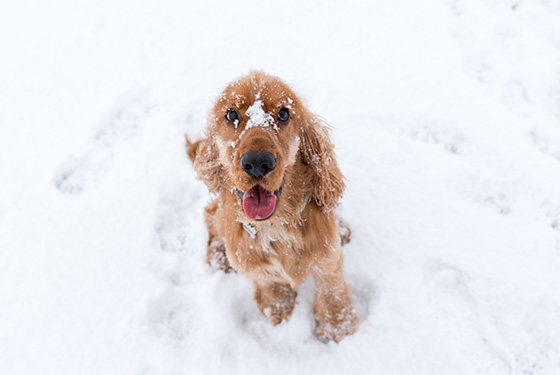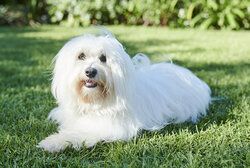When a dog has a cold
Just like us, dogs can catch a cold. The typical symptoms include coughing, purulent nasal discharge, sneezing and shortness of breath. Although household remedies can help, you should definitely make an appointment with the vet.
Symptoms of a cold in dogs
The symptoms of a cold in dogs are not dissimilar to the ones that humans have. These primarily affect the nose, throat and eyes. There can just be one or two symptoms or several can occur simultaneously. The following symptoms are among the most common indications that a dog has a cold:
Folgende Symptome gehören zu den häufigsten Anzeichen einer Erkältung beim Hund:
- Nasal discharge
- Coughing
- Wheezing
- Purulent mucus
- Increased body temperature
- Watery eyes
- Sneezing
- Tiredness
- Fever
- Vomiting
- Loss of appetite

How does a dog catch a cold?
Coughing and a runny nose can indicate that a dog has simply caught a common cold due to cold weather. These could, however, just as easily be the side effects of a different illness. This is why it is important to take your dog to the vet. They will be able to examine your pet in order to determine what may have caused the cold or what the underlying illness is.
Possible causes include the following:
- A common cold caused by cold weather
- Draughts
- Wet fur
- An infection from another dog
- Kennel cough
- Distemper
- Hepatitis
- Fungal infection (aspergillosis)
- Bacterial or viral infection
- Pneumonia
- A Tumour
What should you do when your dog has a cold?
If your dog has any of the above symptoms, you should always consult your vet. This is because the cause may not just be a common cold, but a serious illness that could have far-reaching consequences. This could, for example, result in a harmless condition in the upper respiratory tract spreading to the lower airways and resulting in pneumonia or bronchitis. If your dog is visibly unwell, you should not put off a visit to the vet any longer.
How does a vet treat a cold?
Because of the many possible causes of a cold, the vet will first need to thoroughly examine the dog. As the dog’s owner, you can help the vet to identify the cause by describing all of your pet’s symptoms and letting them know what you think might have caused the cold. Nevertheless, extensive examinations may be necessary.
It is important to be able to rule out any specific conditions that may in some circumstances require surgery. A swab test can be helpful, as can taking the dog’s temperature, a blood test and if necessary an X-ray. Depending on the results, the dog will be given specific medication and, in the case of a bacterial infection, probably also an antibiotic.
What home remedies are there if your dog has a cold?
If your dog has a bad cold, you should always contact the vet. There are, however, a few additional things that you can do to ease your four-legged friend’s ordeal:
- If you have not already done so, you should provide your dog with a cosy dog bed in a place that is warm and draught-free.
- Try to protect your dog from any form of stress and ensure that it gets plenty of rest.
- Only take your pet for short walks.
- Make sure that your dog is able to sleep undisturbed.
- High-quality food can help to strengthen the immune system.
- Your dog should drink as much as possible.
Another tip for colds is inhaling. This may sound strange at first when it comes to a dog, but it is actually quite easy to carry out. The proven home remedies for colds include sage, camomile, thyme and table salt. When heated in a saucepan, they unleash their antibacterial and anti-inflammatory effects and help to clear the airways. It is obviously difficult for a dog to use an inhaler or to keep its head under a cloth, so this requires a trick: here you will need a dog transport box. Place your dog in the box and cover it with a blanket. Position the steaming pot underneath the blanket – but at a suitable distance from the box itself. The dog will then breathe in the soothing steam. You can also do this with a small dog sat on your lap. First of all, place the pot with the hot vapour between your feet. Then, using the blanket, make sure that your pet’s head is in the rising vapours.
How can you prevent your dog from catching a cold in the future?
Sadly, it is not possible to completely avoid a cold or cold-like symptoms, simply because there are so many different causes. There are, however, some ways to significantly reduce the likelihood of your pet getting a cold.
- A dog coat or jacket
Not every dog has thick fur. For dogs without an undercoat, it is advisable to put them in a warm dog coat or jacket on icy or cold, rainy days. - Drying your dog
If a walk with your dog is wet and chilly, it is best to dry your pet thoroughly when you get home. - Do not let your dog eat snow
Dogs should not eat snow, as this can result in snow gastritis, which can cause, among other things, coughing and vomiting. - Having your dog vaccinated
Good basic immunisation protects your dog against all kinds of illnesses including distemper, the symptoms of which include nasal discharge and coughing. If your pet has a lot of contact with other dogs, a vaccination against kennel cough may also be advisable. - A cozy place
Every dog should have one or, even better, two quiet places to retreat to with a comfy dog bed or a basket with a blanket.
You may also like this

Fieber beim Hund
Was tun, wenn der Hund Fieber hat und sich schlecht fühlt?

Dogs in winter
Ideal items, care and nutrition

Vaccinations for dogs
Early basic immunisation protects against diseases

Signs of illness in dogs
Examine your dog regularly for signs of illness

